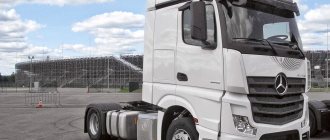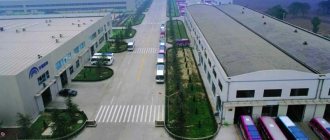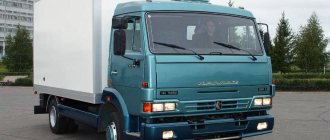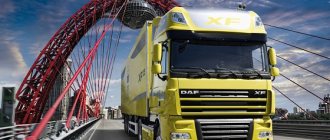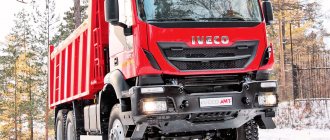Carrot and stick of import substitution
Daniil Minaev, photo by the author
This material is unique - to some extent a subjective excursion into the topic: who produces what equipment, and what of this falls under legislative pressure.
If you are a potential buyer of commercial vehicles, but the activities of your enterprise will fall under the regulation of the Government of the Russian Federation regarding import substitution and a ban on the purchase of certain goods of imported origin, in particular cars, then this article is for you. Let's take a look at the main segments together and see what choices and opportunities there are today. The main thing you need to understand is what type of vehicle you need, its tonnage or passenger capacity.
Only quotes as sources
On August 4, 2015, at a meeting of the Government of the Russian Federation, a decision was made to create a commission on import substitution; this fact is reflected in Resolution No. 785. Two subcommittees were created within the structure of the commission: on issues of civil sectors of the economy and on issues of the military-industrial complex.
As a general rule, when carrying out state and municipal procurement, national treatment is applied to goods originating from a foreign state on equal terms with goods of Russian origin in the cases and under the conditions provided for by international treaties of the Russian Federation (Part 1 of Article 14 of Law No. 44- Federal Law). A similar rule is established for work and services performed and provided by foreign persons.
However, in the same art. 14 of Law No. 44-FZ provides for the right of the Government of the Russian Federation and the federal executive authorities authorized by it to establish restrictions on the admission of foreign products. The Government of the Russian Federation has the right to establish appropriate restrictions on admission or even a ban on admission in cases where this is necessary in order to protect the foundations of the constitutional system, ensure the defense of the country and the security of the state, protect the domestic market of the Russian Federation, develop the national economy, support Russian producers (Part. 3 Article 14 of Law No. 44-FZ). The Ministry of Economic Development of Russia, on behalf of the Government of the Russian Federation, has the right to establish conditions for the admission of foreign products (Part 4, Article 14 of Law No. 44-FZ), including barrier conditions.
To implement the described powers, the Government and the Ministry of Economic Development have established prohibitions and restrictions on the purchase of the following categories of goods.
- Equipment for defense and security needs.
- Food.
- Mechanical engineering products.
Inter is back
How many attempts have there been to start selling new American-made tractors in Russia - and they all ended in nothing! But until now, the initiator was the St. Petersburg company Goodwill Holding: first it certified a couple of Freightliners (I also participated in their transportation), then it assembled a hundred cabover Inters (International tractors) from Brazil, and when the project died out, it brought a new hooded International Prostar to study demand .
International Prostar has already been adapted to Russian conditions
I took a picture of the Prostar cabin, standing on the mattress: the sleeping compartment is not the largest, but the bed itself...
0 / 0
And now, two years later, the hooded Prostar again sparkles on Comtrans. But Goodwill Holding has nothing to do with it: International itself opened a representative office in the center of St. Petersburg and prepared Prostar in the Russian version. Its 430-horsepower engine meets European Euro 5 standards, but is equipped not with “urea” SCR neutralization, but with an EGR recirculation system (which, according to the experience of carriers, is extremely sensitive to fuel quality). The gearbox is a traditional “American” non-synchronized one. The exact price is already known: such a Prostar costs us 147 thousand dollars - that is, approximately 110 thousand euros. If you add six thousand euros, you can get a new Volvo FH! However, the company has eight official dealers (Goodwill Holding is no longer one of them) and there should be no problems with service: the country is full of spare parts stores for “Americans.”
The American Western Star was almost shown at Comtrans: since this is a brand of the Daimler concern, the Mercedes-Benz Trucks Vostok joint venture decided to sell such 40-ton mining dump trucks here. But the dump truck itself was not at the exhibition, and behind the counter with the Western Star emblem there was a bus of another Daimler brand, Setra...
Cars as engineering products
From this meticulous document it indirectly follows that, in general, government purchases of imported automotive equipment are not greatly limited by law. For those who operate highly specialized heavy automotive equipment, a situation may generally arise that there is simply no domestic alternative. But the law is law, and legal practice shows that, if desired, facts can be presented in any form, including distorted ones, which will lead to prosecution and punishment of officials who make decisions on the purchase of certain products. Hence, there is a high probability that the majority of such decision makers will most likely play it safe and set tasks for technical performers to select purely domestic market products. Does this mean that you and I will have to contemplate the meager assortment of not the most modern and reliable domestic auto industry? Whether you like it or not, we all periodically use city buses, we need ambulances, firefighters, and our streets require mechanized cleaning.
MAZ and MAN
MAN has gradually begun assembling trucks at the long-promised plant near St. Petersburg: the process of launching the plant has clearly been delayed, and there has still been no official opening ceremony.
Better late than never: MAN began assembling trucks near St. Petersburg
The supposedly first copy of the St. Petersburg assembly arrived at the exhibition - the TGS WW 6x4 tractor for a 65-ton road train. True, there are doubts about the fact that it is the very first: the VIN ends with the numbers 00038.
“Does the Belarusian MAZ still cooperate with MAN?” - our foreign colleagues asked us. Alas: MAZ-MAN still builds trucks, but is not a joint venture, since the partners have gone their separate ways.
MAZ begins to supply 20 cc bodies. Like the “Chinese”!
The MAZ tractor is not only equipped with a Mercedes “robot”, but also with a Mercedes joystick!
0 / 0
But MAZ is very friendly with Mercedes! But it is not going to unite with KAMAZ, especially in light of recent political events.
The Mazovians themselves invested $35 million in refurbishment of production: cataphoresis treatment of frames and cabins. And the flagship MAZ-5440 Prostor tractor received a lot of components from the Mercedes Actros MP3 model. The engine is a 435-horsepower Euro 5, the gearbox is robotic PowerShift, with a joystick on the armrest, the steering wheel with steering wheel paddles is also Mercedes. For the first time, a color display of the on-board computer appeared on the instrument panel; climate control is included in the package. The capacity of the fuel tanks is a decent 1200 liters. This is a real “SuperMAZ”! And for only 2.8 million rubles.
The MAZ-5440E9 Spacious model has a really spacious cabin and a power unit from the Mercedes Actros MP3 model, including a robotic gearbox
The interior of the MAZ is getting better and better. Among the innovations are a semicircular front panel, a color display, a Mercedes steering wheel, a navigation lamp and a USB connector.
0 / 0
But the MAZ dump truck with the new 20 cc body was disappointing. Builders will drive it onto public roads with overload: according to Russian rules, a three-axle vehicle can weigh no more than 25 tons, but here the load alone will pull more than 30 tons. It turns out that the body was installed to please the customers: they complain that the “Chinese” have hefty bodies, but the MAZs have much less. But we are categorically against such decisions, due to the fact that such heavyweights destroy roads and are simply dangerous. Don't we have enough disasters with overloaded "Chinese"?
Tender tricks
Any action or decision made in the public service implies responsibility. However, in some places the legislation does not clarify the details, making it possible to make difficult choices within the legal framework.
So, for example, by setting requirements for heavy trucks in the tender conditions in the form of a service interval no more than once a year or 100,000 km, you can immediately cut off the lion’s share of national suppliers. On the other hand, the price of such a machine will be significantly higher than most offers.
In principle, you can instruct technical engineers to do a comprehensive analysis and prove that, in the totality of properties, the cost of ownership will be comparable and the efficiency will be higher. But how high must the authority of this official be in order to “reach out to heaven” with such evidence!
There are Russian engineering car assembly companies that use imported chassis and superstructures, but the final product is absolutely legally considered Russian and carries a national VIN. But these are not the most popular products; for example, look at the special equipment of the Moscow data processing center.
And yet, if you don’t dig so deep, is there a choice between KAMAZ, GAZ or UAZ? Let's take a look together.
Distinctive features of the modifications
- GAZ-66 – has excellent cross-country ability (thanks to the 4x4 wheel arrangement), ensures the transportation of large loads over long distances. The truck is widely used in all branches of industry, agriculture, and public utilities. Models produced for the needs of the army deserve special attention;
- ZIL-130 is one of the most popular Soviet trucks. It has a carrying capacity of about 6 tons, weight is 4300 kilograms. The vehicle was used for a variety of purposes, ranging from agricultural sectors to military needs;
- KrAZ-255 – has a 6x6 wheel arrangement, an all-metal platform with open rear sides. Designed for subsequent transportation of large loads in off-road conditions. It has received recognition in the military environment due to its reliability, ease of maintenance, and ease of transporting people in an open body;
- Ural-375 is an all-wheel drive truck with high cross-country ability. It is used for the needs of the economy, various industries, and the army. The mass of the car is 8400 kilograms. More than 110,000 units produced.
Vans and mini-trucks based on passenger cars
Without exaggeration, this is the poorest segment. At the automobile production in Izhevsk, which today belongs to the Volga Automobile Plant, they have long forgotten what “heels” look like, which once sold in gigantic quantities throughout the vast country. If you need something similar, then the VAZINTERSERVICE company produces small trucks, even with refrigerated and isothermal superstructures, based on the Lada Granta and VAZ-2121, which recently returned the name “Niva” instead of the faceless nickname “Lada 4x4”.
The undisputed leader of this market niche in Russia is the Lada Largus, which is based on the first generation Renault Dachia Logan of 2004. The car has taken root well thanks to its unpretentiousness and voluminous cargo compartment with “Zhiguli” external dimensions.
The products from Ulyanovsk, now called the “SGR” family, stand somewhat apart. Archaic but real “rogues” continue to be in steady demand, despite the recently celebrated 60th anniversary...
Ukraine
Production at KrAZ fell from 257 to 203 units. in 2022. The production was based on special equipment for public utilities. The production of passenger cars is beyond profitability and the main replenishment is carried out through the import of new and used foreign cars from Eastern European countries - Romania, Hungary, Poland and the Czech Republic.
Ukravtoprom enterprises produced 875 buses in 2022. In addition, 11 Electron A185 buses were supplied to customers in 2019 by Lviv-based Electrontrans LLC (10 for Uzhgorod and one for the Olvia port in Nikolaev). Another 2 buses under the Tour brand were manufactured by Lvov OJSC Ukravtobusprom. The leader, Cherkasy Bus OJSC, produced 441 Ataman buses. In second place is the Etalon Corporation, which at PrAZ increased its annual production from 188 to 202 buses. In third place is the Chasovoyarsky Automobile Plant from the Donetsk region, which produced 94 Ruta buses. The Zaporozhye Automobile Plant produced a total of 70 buses, including the new A08 on the Weichai AsiaStar chassis and A09 on the Mercedes-Benz chassis. The ZAZ A10S bus has been modernized, and the release of the 12-meter city ZAZ A18 has also been announced. SE “Avtosborochny” produced only 68 buses.
Large class buses in Ukraine are purchased, as a rule, by municipal transport companies, and in 2022 only 204 MAZ buses were imported.
Buses, but not buses
Thanks to the large number of companies turning all-metal vans into minibuses for various purposes, there is no shortage of choice for 12-20-seater passenger vehicles. But if you need a Russian bus of medium and large capacity, then the choice is relatively small, but not so small. The main problem of choice is that there are several manufacturers and models, but inside they all have a set of the same units in different combinations, like from a school construction set...
A whole galaxy of small Russian cooperatives tirelessly builds a variety of “barbuhaiks” on various medium-tonnage truck chassis, mainly of Japanese or Chinese origin. Some are capable of producing a dozen or two in a year, but the production volumes of most of them are just a few, so they are not of particular interest for government procurement.
The main and most reliable player in this field is the GAZ group. Let's start with medium-capacity buses. In Pavlovo-on-Oka you can “stock up” on both the veterans PAZ-32053, PAZ-4234, and the completely modern Vector-NEXT family, or the intermediate product PAZ-3203, PAZ-3204. In the Trans-Ural city of Kurgan, the low-floor KavZ-4239, the completely modern KavZ-4270, or the Aurora family buses KavZ-4235, KavZ-4238, which have long been familiar to government agencies, will be manufactured to order. In Likino-Dulyovo, near Moscow, you will find the LiAZ-4292, which has recently become widespread.
In Neftekamsk, competing with the “gaz” abundance, they recently mastered the urban low-floor NEFAZ-4299.
What about large and extra large capacity buses? Almost all roads lead back to Likino-Dulyovo. Only here in the Russian Federation is the articulated low-floor vehicle model 6213 and a complete set of “single” vehicles produced, including 15-meter three-axle “electric trains”. Suburban, short-distance and service LiAZs can also be found here.
In Tatarstan, the Kama auto giant, based at its plant in Neftekamsk, will today offer several options for the NEFAZ-5299 city bus, with a passenger capacity of about 100 people, with a completely or partially low floor. And here, the only apron bus in Russia for airports with two-way exits will be manufactured to order.
New bus market in 2022
For 2022, the small all-wheel drive PAZ-3206 remained the leader in terms of dynamics among models (an increase of 2.4 to 330 units), with the accordion LiAZ-6213 in second place (+93.7%, 459 units – 5- e place in the market), and in third place is the NefAZ-5299 series (+51.9%, 1218 units). In terms of absolute sales volumes, the small PAZ-3205 is invariably the leader (3,480 units, -3.4%), but the PAZ-3204 family is gradually approaching it, including the PAZ NEXT (total 2,669 units, +8.4% - 5th market dynamics). The average PAZ-4234, which was in the top three for almost the entire year (1176 units, +39.3%), finished in fourth position both in terms of dynamics and sales volumes. UAZ did not announce production in the bus class and the last 4968 units. UAZ-2206 left the warehouse back in 2022.
Sales of buses with a gross weight of over 8 tons fell from 8,893 to 7,623 units.
However, there was a revival of European brands from 100 to 190 units. Sales of MAN and Neoplan buses alone were able to increase from 48 units. in 2022 up to 110 units. – in 2019. Sales of buses with a gross weight over 8 tons in the Russian Federation, by class
| Type | 2019 | 2018 | Growth, % |
| Urban | 5001 | 6566 | –23,8 |
| Suburban | 1891 | 1799 | 5,1 |
| Intercity and tourist | 731 | 528 | 38,4 |
| TOTAL | 7623 | 8893 | –14,3 |
If we examine only the cargo topic, the Sollers group continues to develop the production of medium- and large-tonnage Isuzu, South Korean Hyundai produces two generations of trucks with a gross weight from 3.5 to 10 tons at its Kaliningrad facilities. The specifics of this enterprise are interesting. Since the city of Kaliningrad is located in a special economic zone, it does not ship chassis, but only finished vehicles, which does not prevent it from equipping them with a large selection of superstructures - from simple vans to municipal equipment.
The Nizhny Novgorod region really likes to do this kind of business, where you can see exclusive superstructures on a variety of chassis...
Nuances of choice
There are several criteria that buyers use when choosing a cargo vehicle.
Increased demands are placed on the truck, since the vehicle must work and generate income, and not become an object of constant investment.
In many respects, new trucks produced in Russia are good in this component. The carrier often does not need cutting-edge solutions. The main task is performed in performing direct functions. Vehicles are selected based on the purpose, specific volumes of goods, transported products, distances and duration of trips.
As operating practice clearly shows, the best Russian trucks produced in our country have an optimal price-quality ratio.
As for the requirements, often companies interested in purchasing a good truck focus on the following criteria:
- Compliance with functions and purposes. For this purpose, tilt, onboard models, tanks, large-tonnage, medium-tonnage, light vehicles, tanks, refrigerators, etc. are produced.
- Safety requirements. The machine must provide optimal safety conditions for the driver, as well as guarantee the safety of the cargo.
- Spaciousness and load capacity. Some transportation requires the delivery of a large volume of goods in one vehicle. Therefore, Russian trucks produced in the Russian Federation are divided into appropriate categories depending on their load capacity.
- Driving and performance characteristics. In this component, the current new products among the best Russian trucks have significantly surpassed their predecessors, and also approached the level of top foreign manufacturers. The cars have become more powerful, more torquey, they can easily drive up steep slopes when fully loaded, without tearing the engine apart.
- Operating cost. An incredibly important criterion, which implies the cost of maintaining the machine, its operation, refueling, scheduled maintenance and repairs. Here, Russian trucks have practically no competitors in the local market. Current new products have many of the advantages of more expensive foreign analogues, but at the same time, in terms of operating costs, they are much cheaper.
The vast majority of new trucks, as well as models that have been developed and released over the past 10-15 years, meet these selection criteria, and allow domestic entrepreneurs to count on a good deal when purchasing a Russian truck.
Main cargo trucks with a gross weight of 8 tons and above
The busiest sector no matter what! Domestic pillars from Naberezhnye Chelny and Nizhny Novgorod completely cover all market needs in terms of tonnage and wheel formulas. If you can afford something from the Big Seven, what should you do in our replaced times? Do not give up!
DAIMLER KAMAZ RUS, whose industrial sites are located on the KAMAZ premises, is happy to implement any ideas in the form of the fourth generation Mercedes-Benz Actros family, however, mainly in the form of truck tractors.
Kaluzhsky will accept orders for trucks of the Volvo Trucks and Renault Trucks brands. Moreover, in the case of the Swedish brand, they really like to fantasize with complex multi-axle chassis, so that later they can mount some exotic stuff on them (see “Concepts of high emotions”).
You can also discuss the specifications of German MAN trucks; some of them, at your insistent request, will be assembled in the vicinity of the northern capital.
And if you want Italian cuisine, feel free to go to the Urals, to the city of Miass. The original production of “IVECO AMT” has been successfully combining Russian design ideas in the intricacies of unusual chassis with an Italian component base for almost three decades. But the most interesting machines of this enterprise do not belong to the field of long-distance transportation; they like to work with dump trucks, heavy ones at that, fire extinguishing equipment and off-road equipment.
History of the Russian automotive industry
E. A. Yakovlev is considered the founder of the Russian automobile industry, who successfully demonstrated his four-wheeled passenger car at the All-Russian Industrial Exhibition in Nizhny Novgorod in 1896.
Already in 1900, the first domestic truck, invented by Boris Lutsky, appeared at the World Exhibition. From that time on, the rich history of the Russian automobile industry began.
After the First World War, the problem associated with the shortage of cars in the Russian army had to be solved.
The first automobile factories began to appear in Russian cities:
- in Moscow - for the production of FIAT 15 Ter cars in the amount of 1,500 cars per year;
- Yaroslavl - Crossley 20/25HP in the amount of 1500 cars per year;
- Ryabinsk - 1,500 Renault cars per year;
- Mytishchi, where it was planned to produce 3,000 cars per year.
The 1918 revolution stopped production, but over time everything returned to normal.
Soviet time
The first Soviet car AMO-F-15 was produced in 1924 by the AMO plant. It was from this moment that the development of the Soviet automobile industry began. In 1931-1933, the company was renamed ZIS and began producing cars from the American company Autocar.
Then another enterprise appeared in Nizhny Novgorod - NAZ, which produced cars and trucks. They became the basis of the national automobile industry and provided the USSR with access to first place in Europe in the production of trucks.
In the years 1950–1970, the Soviet automobile industry developed extensively. It is interesting that priority in those years was given to trucks.
With the construction by Italy of the Volzhsky Automobile Plant (VAZ) in Togliatti and the deployment of mass production of Zhiguli and Niva cars at its facilities, mass motorization of the USSR began. A large production facility, IzhAvto, appeared almost from scratch.
In 1980, the Soviet Union ranked fifth in the world in total production, third in the production of trucks, and first in the production of buses. However, at the same time, crisis phenomena began - the growth in production of passenger cars practically ceased, and a shortage of auto parts remained.
Despite the problems in the country, potentially new brands have appeared:
- VAZ-2018 “Sputnik”;
- Moskvich-2141 “Aleko”;
- VAZ-1111 “Oka”;
- ZAZ-1102 "Tavria"
- trucks GAZ-4301 and ZIL-4331;
- buses LiAZ-5256 and LAZ-4202.
Literally the entire country drove Soviet cars.
Modern period
With the collapse of the Soviet Union, the country lost many enterprises located in other countries. Because of this, the automotive industry suffered a protracted crisis.
By the mid-90s, the production of trucks decreased by 5.5 times, large-class buses by 10 times, and passenger cars by a third. As a result, the AZLK and IZh plants, which produced more than 150 thousand inexpensive passenger cars in demand on the market, stopped.
Nevertheless, new models still appeared in Russia:
- VAZ-2110;
- GAZ 3110 Volga;
- GAZ-3302/-2705/-3221;
- "Gazelle";
- ZIL-5301 "Bull"
And although foreign cars are now increasingly common on Russian roads, owners of old Soviet cars do not want to exchange their “swallow” for a new car.
Since 2002, the production of foreign stamps has been established in Russia. Thus, the share of production of foreign brands in the segment of passenger cars was 41.3%, trucks - 7.9%, buses - 9.8%.
In the 2000s, dozens of factories were opened in the country that produced cars under the brands of well-known manufacturers:
- Volkswagen;
- Skoda;
- BMW;
- Ford;
- Renault;
- Toyota;
- Chevrolet;
- Peugeot-Citroen;
- Mitsubishi;
- Nissan;
- Opel;
- Kia;
- Volvo Truck.
In November 2009, Renault-Nissan and OJSC AvtoVAZ signed an agreement on the main terms of the restructuring of the Russian automaker. According to the document, Renault-Nissan will use the production facilities of AvtoVAZ. In exchange for this, the state is obliged to provide financial assistance.
Already in 2016, the total production of trucks, passenger cars and buses in Russia reaches 1,299,926 vehicles per year. It ranks 16th in the world in terms of total output, although the country was ranked 7th in 2012.
Substitution that doesn't exist?
A very interesting situation is developing. With the proper skill, ingenuity and desire to do the job without carelessness and without building a corruption scheme, the decision maker will be able to provide his enterprise with modern and high-quality equipment, subject to sufficient funding. Almost the entire range of vehicles officially supplied to our market is available to government customers, but with some restrictions that are controversial...
For many years in a row, despite various periods of economic ups and downs, the most “squeezed” corner of the Russian national market in terms of imports continues to be medium- and large-capacity city buses and “toy” small trucks. However, why this is so is not difficult to guess.
Imported buses, even taking into account their probable localization, are still incredibly expensive, while remaining social transport, which must be purchased in large quantities and regularly updated, and at the expense of municipalities or other means of state support. At the same time, their passengers are either a preferential category of citizens or have limited ability to pay.
Cargo babies, in turn, are a completely auxiliary branch of the road transportation business, and no one takes them seriously. Such transport is kept on the balance sheet mainly not by carriers, but by companies that need to regularly pick up and deliver something for their internal needs, and often in this case you can get by with an ordinary passenger car...
Main advantages
The Russian car market has created certain stereotypes around itself, which often do not correspond to reality. But if we talk specifically about the truck segment, many stereotypes here do not correspond to the real picture at all.
There is an active and very interesting trend. Many modern multi-tonnage trucks produced in Russia are purchased by foreign companies. Moreover, we are talking about fairly rich and developed countries. Buying Russian cars is cheaper, plus they have a number of undeniable advantages.
- Affordable price. When compared with imported analogues, Russian cargo vehicles are cheaper. Yes, there are more affordable solutions from China, but in this case the quality is too low.
- Market stability. Unlike the passenger car market, which is constantly shaking and prices are actively rising, everything is calm in the cargo segment. This does not stimulate a sharp increase in cost, leaving the domestic truck industry affordable and attractive.
- Wide use. If you want to purchase some Russian-made trucks, you don’t have to travel across the country in search of manufacturers and official dealers. They have representative offices in almost every major city, as well as in all regions. This simplifies not only the purchase issue, but also further maintenance, repairs, purchase of spare parts, etc.
- The pursuit of excellence. Market research in recent years clearly demonstrates that Russian developers do not stand still. They regularly improve their cars, release new solutions, come up with original and unusual cars that can become a real salvation for many enterprises when solving cargo transportation issues. It’s not for nothing that domestic cars receive many international awards and prestigious awards.
- Partnerships with foreign manufacturers. Close cooperation with foreign companies played an important role in improving the quality and capabilities of new Russian trucks.
As a result, modern domestic trucks have become more technologically advanced, more powerful, more economical and more relevant.
ZIL named MAZ
“What, ZIL still produces trucks? And why is there a MAZ snow blower at his stand?” — the visitors were surprised. Let's talk briefly. The territory of ZIL itself is now being redrawn and rebuilt, and the production of Bychkov has been moved to the small town of Petrovsky near Smolensk.
MAZ is at the ZIL stand! This truck was assembled at the Zilovsky branch in Smolensk
As for the MAZ at the stand, it was assembled using the large-knot method and equipped with its own cleaning equipment by another branch of ZIL - the Smolensk Automotive Aggregate Plant. Moreover, the gearbox here is its own, made from Smolensk, and the axles are completely Chinese FAW! The price of the chassis is 1 million 270 thousand rubles, the price of attachments is 700 thousand rubles. The prospects are still unknown: specimen No. 001 was at the exhibition. And what will happen to ZIL itself and its branches? No matter how this “MAZIL” turns out to be Zilov’s last project...
For the first time, KAMAZ and Galichanin showed a truck crane on a five-axle chassis with the index 7330 and a 10x4 wheel arrangement: the last electronically controlled axle is Dutch, the same as on GINAF multi-axle trucks. The price of the chassis is 5 million rubles, the entire crane is 14-15 million rubles. In October, KAMAZ promises to build a 10x10 chassis with a low-slung cab
Chinese bazaar
The Chinese “truck” auto industry was protected this time only by the Dongfeng company: it brought a whole range of vehicles, including pickups, minibuses and trucks with a cabin “like a Nissan Cabstar”, but they are not for sale yet. But on the bodies of the dump trucks it is written “VH-Dongfeng” - the Belgian Serge Van Hoole, known from the VH-DAF company, will now sell not only Dutch, but also Chinese trucks with us! The price of a Dongfeng 6×4 dump truck is typical for the “Chinese” - 2.8 million rubles.
Chinese “shop of happiness”: any headlight – $45, radiator grill – $150
For the first time, Naveco Yuejin, a product of the Italian-Chinese joint venture Naveco, arrived in Russia. But Iveco has nothing to do with its sales in Russia: representatives of the Ryazan plant Tsentrtranstekhmash will sell the car. And what’s Italian here is the only licensed 2.8 diesel engine and gearbox made in China. The carrying capacity of the chassis is about three tons, the price of the chassis without the “booth” is 750 thousand rubles.
And at one of the stands of Chinese spare parts manufacturers there was a real “stall” selling lighting equipment and false radiator grilles.
In AR No. 14, 2013, we said that in Siberia there is a problem with headlights for American Volvo VN: they must be ordered from the USA, and the “original” is very expensive, so local craftsmen adapt headlights from Lada Priora.
Chinese with Italian: Naveco Yuejin has an engine and gearbox licensed by Iveco
— How much does a headlight cost for an American Volvo? - we ask.
- Only forty-five dollars! Any headlight we have costs that much!
— Are there any headlights for the new Mercedes Actros tractor?
- Certainly.
— And for the newest Volvo FH, what are they standing in the next room?
- Of course! As soon as the production of a model begins in Europe, we immediately have spare parts for it.
But what is the quality of this product? By the way, the USB flash drive with press information that Dongfeng gave us was “disassembled” into pieces the first time it was used...

